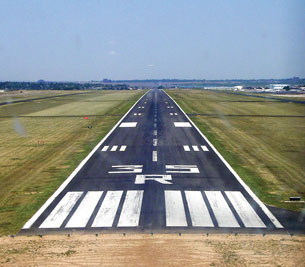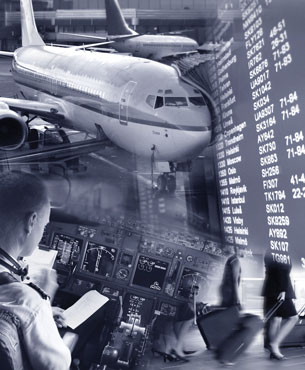Module 1—Motion
 Reflect and Connect
Reflect and Connect

© Craig Mills/shutterstock
There are many cases of airplane crashes related to runway length. For example, in August 2006, Comair Flight 5191 crashed at the airport at Lexington, Kentucky, killing 49 of the 50 people onboard. The plane ended up nearly a kilometre from the end of the runway when the pilot attempted to take off from a runway that was too short. Why do such accidents occur? Using kinematics principles, you are able to explore what variables would need to be known and how they would be used to determine a safe runway length. Would it be the same for both the takeoff and landing of a specific type and size of plane?

© Mikael Damkier/shutterstock
 Discuss
Discuss
Believe it or not, airports and runways are a relatively new technology. Less than 100 years ago, all a plane could land on was a long, semi-flat grass field. (This style of runway can still be found today in rural and remote areas.) However, the increased air travel that emerged after World War I led to the construction of paved runways. This meant that planes had to approach the runway from a specific direction and elevation, which led to such things as visual aids to help pilots land safely. Following World War II, airports became much more sophisticated, with terminals and multiple runways. In 1960, airport construction boomed. At the same time, commercial air travel became commonplace. Runways were extended to a length of 3 km to accommodate larger, heavier aircraft.
Using the discussion area, investigate and discuss modern airport and runway design. You may find answers in a library or, if you do an Internet search, by using keywords in combination such as “airport runway design.”
D 1. Explain how runway numbers are designated.
D 2. Explain how kinematic principles are applied to the following operational components of
- a modern airport
- air-traffic control
- ground-traffic pattern control
- runway length
- navigational aids
- lighting and signage
- wind indicators
- noise reduction
To find out the causes of the Air France crash or to see pictures, videos, and eye-witness accounts, do an Internet search using keywords such as “Air France crash Pearson video.”
 Reflect on the Big Picture
Reflect on the Big Picture
In this lesson you learned more about how mathematics can be used to describe motion. You also saw how mathematics and graphical descriptions are related. Understanding how the pictures and the equations support each other will be important as you describe and analyze motion.
To help you reflect on your learning experience in this lesson, complete at least one of these three activities.
- Mathematics, like poetry, packs a massive amount of content into a small package. Understanding how to unpack the content can be difficult sometimes. Create a poem or short story that helps unpack the mathematics into a description of moving objects.
- Create a mind map that links the concepts developed in this lesson with the graphical methods of earlier lessons.
- Write words to a song that put together the concepts of this lesson in a meaningful way.
Store your completed reflection in your Physics 20 course folder.
 Module 1: Lesson 5 Assignments
Module 1: Lesson 5 Assignments
Remember to submit the Module 1: Lesson 5 Assignment to your teacher.
Add to the KWL chart you worked on in Lessons 1 to 4. Continue to store your chart in your Physics 20 course folder.